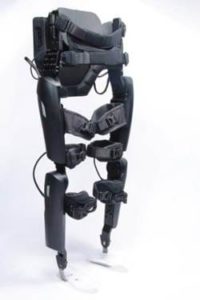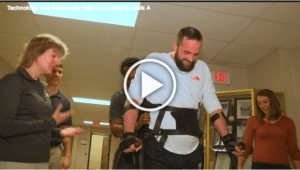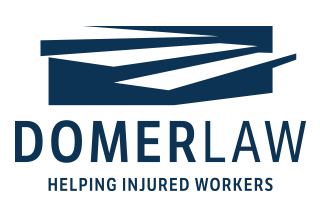
I just witnessed someone without the use of their legs actually walk!
A young paraplegic-supposedly bound to a wheelchair on a permanent basis-used a robotic device and actually stood upright and walked forward. The emotions involved defy adequate description, especially for someone included on the team that made this event happened.

This story begins, like many work injuries, with an unexpected traumatic event. On November 13, 2008, Matt Nevaranta was a 22-year-old working a construction job in hopes of saving enough money to continue his college career. Those dreams were cut short when 3,000 pounds of metal forms fell on Matt, severing his spinal cord. Matt was lucky to be alive. However, the injury damage resulted in permanent paraplegia-an inability to use his legs and all bodily functions below his waist. Matt presumably was constrained to a wheelchair for his life.
For many individuals, such an injury could drastically alter their outlook on life. Matt, though, is a unique young man, who I had the privilege to get to know and represent as his worker’s compensation attorney. Despite his condition, Matt remained positive and persevered daily. He continued to better himself since his traumatic injury.
Matt vigorously pursued his educational opportunities. After the initial shock and recovery from the injury, Matt reenrolled in college, beginning online. He ultimately attended full-time at Cardinal Stritch University (in Milwaukee, WI)-actually driving himself and using his wheelchair for classes. While many worker’s compensation insurance companies demean or question the motivation level of injured workers, Matt disproved those misplaced assumptions. Matt graduated from Cardinal Stritch in the spring 2016 while his bachelor’s degree. Moreover, he volunteers at the Milwaukee County Courthouse in a legal clinic, and he now has applied for law school!
Matt also forcefully pursued his physical betterment and the necessary medical equipment. Under the Worker’s Compensation law, an injured worker receives medical treatment that is reasonably required to cure and relieve from the effects of the injury. (Wis. Stat. Section 102.42(1)). In Matt’s case, his worker’s compensation insurance company provided a number of medical items since the injury, including a seated wheelchair, an upright wheelchair, and home and car accommodation modifications. None of this treatment, however, resulted in Matt walking.
ReWalk allowed Matt to walk. ReWalk is a wearable robotic, motorized exoskeleton that allows individuals with spinal cord injuries to stand upright and actually walk. During my representation, Matt asked if his worker’s compensation insurance company would pay for the ReWalk device. Matt met all of the necessary criteria (as established by ReWalk) and had medical clearance to obtain the device. More importantly, Matt’s treating spinal cord specialist and psychologist provided their medical opinions about the significant physical and psychology benefits involved in the potential use of this device.
A legal battle ensued. In part, due to the “not-cheap” device cost, the worker’s compensation insurance company denied payment for the device. The insurance company also hired their own “independent” medical record reviewer to question the benefits of the device. We filed numerous medical literature studies showing the physical benefits of an upright motorized exoskeleton for paraplegics (notably, many of these devices have been used to assist returning military veterans). We also filed medical opinions noting the potential cardiovascular, gastrointestinal, spasticity, life expectancy, and psychological benefits to the device.
The dispute over the ReWalk device went to a worker’s compensation trial. (Note that worker’s compensation attorneys cannot receive a fee on medical treatment expenses, so this was pro bono representation). Matt testified about his desire to use the ReWalk device.
And we won. In a first-of-its-kind case in Wisconsin, the administrative law judge ruled that the ReWalk exoskeleton device was a reasonably required medical treatment or modality to cure and/or relieve from the effects of the work injury. Thus, the worker’s compensation insurance company was ordered to pay for the device.
The parties struck a subsequent reasonable deal for the cost of the device to avoid further appellate litigation. As part of this deal, we worked with the amazing crew at Marquette University’s physical therapy department (shown in the video clip in detail), who provided further training to Matt free of charge. Matt now goes to training at Marquette, and I was privileged to watch Matt in action.
I watched a paraplegic walk!
Such a worker’s compensation success would not be possible without an entire team supporting Matt, including the efforts from Domer Law, Matt’s family, the ReWalk team (especially Craig Peters), the physicians at Froedtert/Medical College of Wisconsin (especially Drs. Merle Orr and Brad Grunert), and Marquette University physical therapists. But, of course, none of this would occur without the personal drive to excel found in Matt Nevaranta. Great work Matt, and I wish you nothing but continued success.


